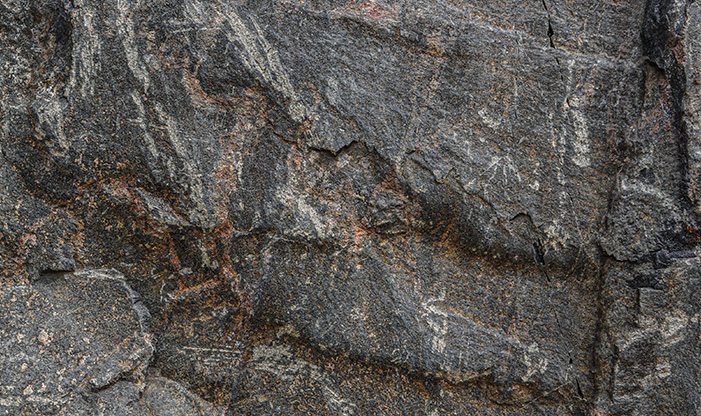The landscape surrounding the greater Milwaukee area has taken many forms and changed many times throughout the millennia. There are distinct periods, lasting millions of years, during which the land, rocks, water, and wildlife were composed in dramatically different ways and existed within highly distinct climates. Remnants of those ancient times can be observed throughout the Milwaukee area, including at Schlitz Audubon, allowing viewers to wonder at the dramatic changes our local environment has undergone.
The Ages of the Earth
Based on radiometric data, scientists believe the earth formed around 4.54 billion years ago. The first continents began to coalesce over 3 billion years ago, and at times formed supercontinents. The most recent was called Pangaea. Roughly 200 million years ago, due to plate tectonics, Pangaea gradually broke up into the seven continents we identify today.
Geologic formations in Wisconsin are visible from as far back as 3 billion years. The oldest rock found here, granite gneiss, was discovered near Wisconsin Rapids and dates to 3.268 billion years old. Such rocks are tell-tale signs of intense volcanic activity. Much of what’s recorded in Southeastern Wisconsin is from a more recent time. As the location of Wisconsin changed as the continents drifted, fossil evidence shows that shallow seas existed here as well.
Geological time is divided into eras: the Precambrian, Paleozoic, Mesozoic, and Cenozoic. Each of these eras is subdivided into shorter periods. The rock records in Southeastern Wisconsin and Milwaukee date from the early Paleozoic era, which started about 540 million years ago. The three periods in the Paleozoic era visible here are the Ordovician, Silurian, and middle-Devonian. Paleozoic rocks are almost exclusively sedimentary – rock built up in layers due to the action of water.
Rock Layers Beneath Milwaukee
During excavation of the MMSD Deep Tunnel Project, which serves as a reservoir for excess stormwater during intense Milwaukee rainstorms, several layers of rock that Milwaukee is built upon were revealed. The tunnels reach depths of 275 – 340 feet, far into the bedrock; revealing once-hidden details from those three periods of the Paleozoic. These periods together range between 488 and 358 million years ago. There are no rocks younger than the middle-Devonian period in Wisconsin due to factors such as erosion, glacial activity and general lack of deposition. The rocks and their contents from the three visible periods are exposed in numerous areas throughout the Milwaukee area and can be found during short hikes to familiar places.
Ordovician Period
The Ordovician period, 488 – 443 million years ago, left behind the oldest rock formations that we can observe locally. This period was marked by a warm shallow ocean that covered much of the state. Such seas rose and fell several times throughout the Paleozoic Era. A common sedimentary rock from this period is dolostone, composed of the minerals calcium and magnesium carbonate. Close observation of dolostone today, sometimes called dolomite, yields evidence of once-abundant sea life.
Sandstone is another prevalent sedimentary rock found throughout the region from the Paleozoic era. Sandstone, indicative of wind and water erosion, was also coupled with volcanic ash that was blown into Wisconsin from eruptions on the east coast 450 million years ago! The ash shows up as thin clay layers. During this time, the sea bottom was rich with carbonate deposits of corals, clams, brachiopods, and crinoids: all of which can be found as fossils today.
Silurian Period
During the Silurian period, from 443 to 419 million years ago, Southeast Wisconsin was again covered by a tepid, shallow saltwater sea. Wisconsin was located then at 20 degrees South latitude, below the equator. Common rocks deposited were limestone, shale, and dolomite. Sedimentary rocks of this period left strong building material that is commonly used today. The transition from limestone to dolomite erased some of the fossil record, though evidence of life from the Silurian Sea abounds. Fossilization left calcium-rich deposits which are still visible.
Fossils from this time include bivalves, visible as shells, cone-like cephalopod shells, from ancient relatives of squid, gastropods, which are snail shells, and trilobites, which are small arthropods that are now the Wisconsin state fossil. Crinoids, ancient sea lilies, are often seen individually as circular fossils in rocks, which accumulated at the bottom of the sea.
For the first time, coral reefs formed, some over 10 meters tall. These can be seen in numerous Milwaukee locations, including near American Family Field and the nearby Milwaukee Soldiers Home, and at Schoonmaker Reef, spanning six blocks from 62nd to 68th Streets north of State Street in downtown Wauwatosa. Schoonmaker Reef is also important because, in 1862, it was the first reef to be defined in North America. When visitors to the Lake Michigan shoreline go rock and fossil hunting, they may also discover individual coral pieces, such as honeycomb coral, chain coral, and tube coral.
Devonian Period
Oceanic conditions continued into the Devonian Period, which lasted from 419 to 358 million years ago, and by the end of it the inland waters likely retreated. Though there is no record of the end of the Devonian Period in Wisconsin, states adjacent to Wisconsin don’t possess evidence for the remaining presence of an ocean.
During this period, which is exposed in the rock record in the northern parts of Milwaukee, the earliest modern vascular plants developed. Many of the same fossils from the Silurian Period are visible in Devonian rocks. The Devonian Period is visible in exposed rock at Estabrook Park, near the shore of the Milwaukee River. Together with the Silurian rock, the Middle Devonian Milwaukee Formation forms a continuous, 650-mile bedrock layer all the way to Niagara Falls, New York, called the Niagara Escarpment.
Evidence from the Glacier
Wisconsin was also an intermittent center of glacial activity over the last 100,000 years. Some scientists believe we are still living in an Ice Age, within an interglacial period, or time between glaciers. The last glacial period, termed the Wisconsin Glaciation, began approximately 100,000 years ago. It advanced from Quebec into the state 26,000 years ago and completely retreated by 10,000 years ago. Glaciers covered northern and eastern Wisconsin and left broken material from the Ordovician, Silurian, and Devonian Periods in the Milwaukee area. Details of post-Devonian geologic activity likely were erased from the record. The western part of the state, called the Driftless Area, escaped being covered by the glacier and has a completely different topography from the rest of Wisconsin.
Geological Activity and Human Settlement
Much human activity within the state, both that of indigenous people and settlers from Europe, has been influenced by the topography, as well as rock and mineral deposits. Food procurement and production, hunting, transportation, and other economic activities have all been dependent on the geologic remains of the past. Windblown silt accumulated across the landscape and was carried by glacial rivers, creating layers of loess, which became Wisconsion’s rich soil, a boon for the agriculture of indigenous people and settlers alike.
Human settlement was also greatly impacted by the sheer number of water bodies that were formed. Transportation systems were created on Wisconsin rivers and lakes. Rivers also powered mills and generated power. Lake Michigan, which was carved out of shale during the Wisconsin Glaciation, has had an important role in transportation and settlement throughout the region.
When people from Northern Europe emigrated to Wisconsin, they brought knowledge of how to use ancient rocks, including making construction materials from the abundant limestone. Silica-rich sand is still mined and can be used to make glass.
Geological Remnants at Schlitz Audubon
For a walk through history right here at Schlitz Audubon, visit our recently constructed Bluff Pavilion Courtyard, which is made of locally sourced limestone from Beaver Dam. A close look at the pale-colored rock reveals small, fossilized worm holes made by ancient creatures. Fossil hunters on the Lake Michigan shoreline regularly discover fossilized crinoids, coral pieces, brachiopods, and find many types of ancient rocks. Even the rock that forms our Visitor Center is made from ancient limestone, deposited during the Paleozoic. The geologic activity of Wisconsin has left its mark in the region and can be observed throughout our nature center.
With contributions from Tom Finley, Jacob KempinskI, and Melanie Ziolecki


